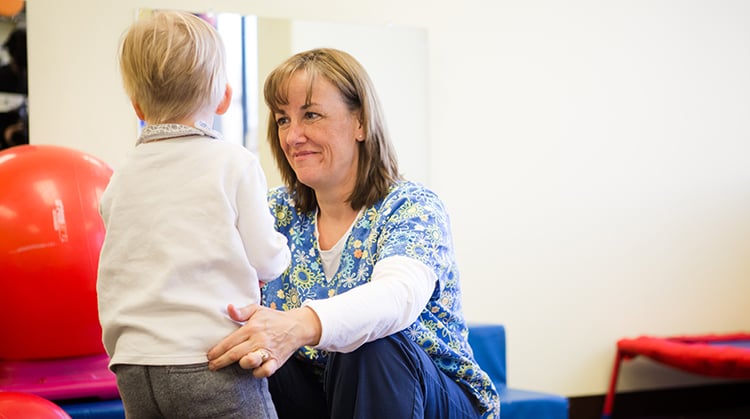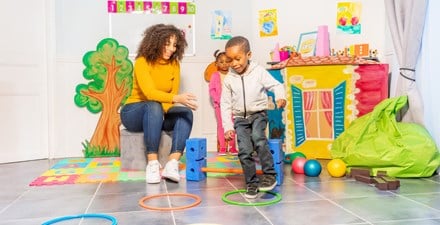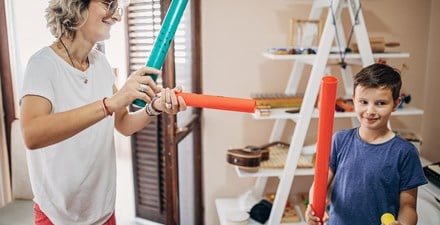Physical Therapy Guide to Autism Spectrum Disorder
Autism spectrum disorder is a group of developmental disabilities that affects how people experience the world. ASD can involve learning, thinking, and problem-solving challenges that range from mild to severe. Difficulty with social interaction is common in people with ASD, but it and other symptoms vary in nature and their impact. Children with ASD often fall behind their peers in developing motor (movement) skills. They also may have coordination and balance problems. ASD occurs in people of all racial, ethnic, and economic backgrounds. It is about four times more common in boys. In girls, the condition may go undetected. About 1 in 54 children in the United States has ASD. Physical therapists help people with ASD develop movement skills to promote physical activity and improve their physical and mental well-being.
Physical therapists are movement experts. They improve quality of life through hands-on care, patient education, and prescribed movement. You can contact a physical therapist directly for an evaluation. To find a physical therapist in your area, visit Find a PT.
What Is Autism Spectrum Disorder?
Autism spectrum disorder is a developmental disability. It causes social, communication, and behavior challenges ranging from mild to severe. Children with ASD can have delays in developing basic skills. While some learn to speak, others communicate in different ways. They also often have trouble connecting with others. People with ASD also may develop strong interests in certain objects or topics. They also may engage in repeated behavior patterns. Copying other people’s actions may be hard for people with ASD.
Signs of ASD begin in late infancy or early childhood, but sometimes go unnoticed until the child is older. The signs of ASD continue throughout the life span. Before 2013, the medical community used various names to describe autism. In 2013, the American Psychiatric Association merged all autism categories into an umbrella diagnosis of ASD. The term "spectrum" allows for variations in symptoms and behaviors. The Centers for Disease Control and Prevention, using the APA’s Diagnostic and Statistical Manual of Mental Disorders (DSM-5), describes ASD in more detail.
The causes of ASD are unknown. Factors that make a person more likely to develop ASD may include:
- Environmental.
- Genetic.
- Biological.
The number of children diagnosed with ASD is growing. Better efforts to diagnose ASD may relate to the increase in cases. It may also be due to an increase in the yet-to-be-understood causes of ASD.
People with ASD may have impaired motor (movement) skills. Research shows those with ASD can have limited coordination and postural control. They also may have to work harder to learn skills through imitation and by observing and moving with others. Planning and completing certain movement skills are also difficult for many with ASD. Delays in these movement skills can make it harder throughout life for people with ASD to:
- Perform everyday activities.
- Connect and play or engage in activities with peers.
- Engage in physical activity for their overall health.
Although motor challenges are not in the current diagnostic criteria for ASD, around 87% of people with ASD have movement problems. However, according to a recent analysis, only about 31% receive physical therapy and 13% receive recreational therapy. Some people with ASD may lack access to services that could improve their motor skills.
Research also shows intervention programs, including physical therapy, can help children with ASD. These programs help them learn skills and improve their motor and overall development. Early diagnosis can help children with ASD reach their full potential. Physical therapists are valuable members of the health care team for those with ASD and their families. Physical therapy can provide benefits from early childhood through the school years and into adulthood.
Signs and Symptoms
The signs and symptoms of ASD vary widely. ASD is a "spectrum" disorder because the symptoms displayed can be mild to severe. People with mild symptoms are at one end of the spectrum. Those with more severe symptoms are at the other end.
Symptoms begin in early childhood and last throughout a person's lifetime. With treatment, symptoms can improve over time. Parents may notice symptoms of ASD before their child's first birthday. By age two, between 80% to 90% of parents see symptoms that interfere with their child's functions.
The core signs a person may have ASD are:
- Challenges with communicating and interacting with others.
- Restricted interests in objects or topics. For example, a child may develop a strong interest in one thing such as cars, dinosaurs, or recycling while ignoring other things.
- Repetitive behaviors such as hand flapping, finger flicking, or body rocking.
Signs and symptoms related to communication and social interaction may include:
- Avoiding eye contact.
- Preferring to play alone and not engage in creative play.
- Showing little interest in peers.
- Not engaging with others.
- Shunning or resisting physical contact.
- Having trouble understanding other people's feelings, body language, and tone of voice.
- Having a poor sense of personal space boundaries.
- Showing delayed speech and language skills.
- Lacking the ability to point or respond to pointing.
- Repeatedly speaking on a preferred topic or repeating words or phrases.
Signs and symptoms related to restricted, repetitive patterns of behavior may include:
- Self-stimulation through repeated activities.
- Being easily upset by minor changes, or having a need to keep routines.
- Obsessive interests, such as lining up toys or other objects.
- Short attention span, except for preferred topics or activities.
- Aggression, self-injury, or temper tantrums.
- Lack of safety awareness.
- Distinctive reactions to sound, smell, taste, sight, touch, or movement.
Other traits of ASD related to movement include:
- Delays in walking, jumping, skipping (large movement skills).
- Delayed hand skills, like buttoning a shirt or drawing a picture (small movement skills).
- Trouble mimicking others’ movements (such as performing actions to songs with peers or jumping over a small object).
- Lack of coordination.
- Poor balance.
- Problems planning and repeating movements.
- Trouble doing movements in a specific order.
- Unstable walking.
- Trouble controlling posture.
- Decreased eye-hand coordination.
- Difficulty using sensory information (such as touch, sound, and gravity) for movement. (These problems may range from slow to exaggerated responses. A person with ASD may appear to have low energy or they may be overactive and crave movement.)
- Walking habitually up on tip toes.
How Is It Diagnosed?
If you suspect your child may have ASD, contact a doctor. A correct diagnosis is the first step toward getting the help your child may need. The doctor may refer your child to a specialist for an in-depth evaluation and diagnosis. Specialists who diagnose ASD (or rule it out) include:
- Developmental pediatricians.
- Child neurologists.
- Child psychologists.
- Child psychiatrists.
The autism diagnostic and treatment team may consist of:
- Physical therapists.
- Occupational therapists.
- Speech-language pathologists.
- Psychologists.
- Developmental pediatricians.
There is no specific medical test to diagnose ASD. Health care providers will consider parent-reported concerns and observe your child. They may use screening tools to investigate. These tools may include:
Screeners
- Modified Checklist for Autism in Toddlers — Revised (MCHAT-R).
- Screening Tool for Autism in Toddlers and Young Children (STAT).
Assessments
- Autism Diagnostic Observation Schedule (ADOS).
- Autism Diagnostic Interview — Revised (ADI-R).
To confirm an ASD diagnosis, a child's behavior and development must meet specific criteria. People diagnosed with ASD have symptoms that make it difficult to function. These symptoms are present from early childhood. Symptoms can go unnoticed until the child is older when social demands increase. Parents may recall symptoms they didn't understand as ASD at an earlier time.
How Can a Physical Therapist Help?

Physical therapists have unique training in child development and motor control. Their expertise allows them to assess a child's motor delays and functional performance. Physical therapists work with your child, the family, and your child's school to help them:
- Engage in and improve daily activities / routines at home and school.
- Learn new movement skills.
- Develop better limb and body coordination and a more stable posture.
- Improve play skills, such as throwing and catching a ball with another person or playing in small groups.
- Take part in games and sports, and physical education classes.
- Develop motor imitation skills (learn by copying another person's actions).
- Increase their fitness and stamina.
A physical therapist will evaluate your child thoroughly. This will include taking a health history and asking questions about your child’s development. Your physical therapist also will assess your child’s:
- Postural strength and control.
- Functional mobility (such as walking and running).
- Body and safety awareness.
- Limb and body coordination.
- Play skills.
- Interests and motivators.
- Ability to change between different activities.
- Unique movements, such as how they jump, hop, pedal a tricycle or bicycle, and skip.
- Daily routines in the home, community, and school.
Your physical therapist will partner with you to set goals and create a treatment plan for your child's and family's needs. They will work with you and your child to help them participate as fully as possible at home and school. They may employ specific principles when working on movement activities, such as:
- Providing consistent session structures (spaces, people, and routines).
- Using a visual schedule of pictures or icons to represent their day or the steps to an activity.
- Employing simple language and clear instructions.
- Using appropriate prompts and encouragement.
- Managing sensory input.
- Offering trial-and-error-based practice.
Each child's challenges and goals are different. Your physical therapist will personalize a program to meet the strengths and needs of your child. They will help you monitor your child's progress. They also will collect data to ensure the plan is helping your child and adjust the plan as your child makes progress.
Physical Therapy in the Early Years: Birth to Age 3
Early delays in your child's movement skills may predict ASD. Reporting symptoms right away can enable early diagnosis so your child can get the help they need sooner.
Physical therapists work with families and caregivers. Their goal is to increase a child's ability to engage in the daily routines that may challenge them.
Physical therapists work with your child to develop age-appropriate movement skills. They use free and structured play to teach your child and help them practice skills. Physical therapists can help your child improve their strength and coordination. Their treatment plan can include helping your child walk safely and efficiently or use stairs. Your child's physical therapist may prioritize the development of imitation skills. They may work with your child to perform indoor and outdoor play skills. Physical therapists guide you and your child on adding structure, routines, and physical boundaries into daily life. They promote positive behaviors and help your child play with their peers.
Physical Therapy in the School Years (Including Preschool): Ages 3 to 18
Physical therapists use the most effective treatments to minimize your child's challenges. Your child's physical therapist will work with you to help make the school experience a positive one.
In addition to helping students with ASD, physical therapists work with parents and teachers to improve awareness. They also help school staff understand your child's ability to function in school. Physical therapists also recommend changes at home and school to help your child thrive and to support their learning. These may include using:
- Ball chairs to reduce "out-of-seat behaviors."
- A hula hoop, carpet square, or special seat to mark personal space.
- Whole-class movement breaks.
- Strategies to teach skills needed to play social games.
Physical therapists help to improve a child's ability to manage challenges. For example, they work with your child to help them deal with school bus steps, crowded hallways, the lunchroom, and the playground. Physical therapists may team with schools to promote skills like self-control, listening, and taking turns. They teach your child practices to promote their ability to:
- Copy the movement activities of other children.
- Develop concepts of direction, body and spatial awareness, and coordination.
- Take part in physical education and fitness activities like exercise, games or sports, and aquatic therapies. They also may incorporate creative movement using music, dance, yoga, exergaming, and martial arts.
In addition to physical benefits, these activities also promote improved social communication, cognitive function, decision making, and everyday skills.
Physical Therapy During Adulthood: Age 18+
Physical therapists work with adults with ASD to promote success in daily life. They recommend community resources to increase movement. Physical therapists also design personalized exercise programs. These exercises promote physical fitness, body coordination, recreation skills, decision making, and social bonding. Physical therapists help adults improve movement, function, and fitness. These skills help people with ASD get and hold a job. They also help them function at home, enjoy activities, and keep a healthy lifestyle.
What Kind of Physical Therapist Do I Need?
All physical therapists have the education and experience to treat people with ASD. However, you may want to consider:
- A physical therapist with experience in treating people with ASD. Some physical therapists focus on pediatrics (treating children).
- A physical therapist who is a board-certified specialist in pediatrics or who completed a residency in pediatric physical therapy. This physical therapist has advanced knowledge, experience, and skills that may apply to ASD.
Find a PT, provided by the American Physical Therapy Association, can help you search for physical therapists near you with these and other credentials.
General tips when looking for a physical therapist (or any health care provider) include:
- Ask family, friends, or other health care providers to recommend a physical therapist.
- Ask about the physical therapist’s experience working with children with ASD.
- Be prepared to describe your child’s symptoms and family’s needs in detail.
The APTA Academy of Pediatric Physical Therapy contributed to this consumer resource. It is for informational purposes only and is not intended to represent the position of APTA Pediatrics.
The American Physical Therapy Association believes that consumers should have access to information to help them:
- Make informed health care decisions.
- Prepare them for their visit with a health care provider.
The following resources offer some of the best scientific evidence related to physical therapy treatment for autism spectrum disorder. They report recent research and give an overview of the standards of practice both in the United States and internationally. They link to a PubMed* abstract, which may also offer free access to the full text, or to other resources. You can read them or bring a copy to your health care provider.
Bhat A, Iverson J, Bishop S, et al. Should motor impairment be added to the diagnostic criteria for autism? Spectrum News. Published January 11, 2023. Accessed January 11, 2024. https://www.spectrumnews.org/opinion/cross-talk/should-motor-impairment-be-added-to-the-diagnostic-criteria-for-autism/
Bhat AN. Multidimensional motor performance in children with autism mostly remains stable with age and predicts social communication delay, language delay, functional delay, and repetitive behavior severity after accounting for intellectual disability: a SPARK dataset analysis. Autism Res. 2022;16(1):208–229. Article Summary in PubMed.
Cleffi C, Su W, Srinivasan S, Bhat A. Using telehealth to conduct family-centered, movement intervention research in children with autism spectrum disorder during the COVID-19 pandemic. Ped Phys Ther. 2022;34(2):246–251. Article Summary in PubMed.
Bhat AN. Motor impairment increases in children with autism spectrum disorder as a function of social communication, cognitive and functional impairment, repetitive behavior severity, and comorbid diagnoses: a SPARK study report. Autism Res. 2021;14(1):202–219. Article Summary in PubMed.
Amonkar N, Su W, Bhat A, Srinivasan S. Effects of creative movement therapies on social communication, behavioral-affective, sensorimotor, cognitive, and functional participation skills of individuals with autism spectrum disorder: a systematic review. Front Psychiatry. 2021;12:722874. Article Summary in PubMed.
Bhat AN. Is motor impairment in ASD distinct from developmental coordination disorder? A Report from the SPARK study. Phys Ther. 2020;100(4):633–644. Article Summary in PubMed.
Hedgecock J, Dannemiller L, Shui A, et al. Associations of gross motor delay, behavior, and quality of life in young children with autism spectrum disorder. Phys Ther. 2018;98:251–259. Article Summary in PubMed.
Holloway J, Long T, Biasini F. Relationships between gross motor skills and social function in young boys with autism spectrum disorder. Pediatr Phys Ther. 2018;30(3):184–190. Article Summary in PubMed.
Colebourn J, Golub-Victor A, Paez A. Developing overhand throwing skills for a child with autism with a collaborative approach in school-based therapy. Pediatr Phys Ther. 2017;29(3):262–269. Article Summary in PubMed.
Srinivasan SM, Pescatello LS, Bhat AN. Current perspectives on physical activity and exercise recommendations for children and adolescents with autism spectrum disorders. Phys Ther. 2014;94(6):875–889. Article Summary in PubMed.
Downey R, Rapport MJ. Motor activity in children with autism: a review of current literature. Pediatr Phys Ther. 2012;24(1):2–20. Article Summary in PubMed.
Sowa M, Meulenbroek R. Effects of physical exercise on autism spectrum disorders: a meta-analysis. Res Autism Spectr Disord. 2012;6:46–57. Article Summary.
Fragala-Pinkham MA, Haley SM, O'Neil ME. Group swimming and aquatic exercise programme for children with autism spectrum disorders: a pilot study. Dev Neurorehabil. 2011;14(4):230–241. Article Summary in PubMed.
Anderson-Hanley C, Tureck K, Schneiderman RL. Autism and exergaming: effects on repetitive behaviors and cognition. Psychol Res Behav Manag. 2011;4:129–137. Article Summary in PubMed.
Bhat AN, Landa RJ, Galloway JC. Current perspectives on motor functioning in infants, children, and adults with autism spectrum disorders. Phys Ther. 2011;91(7):1116–1129. Article Summary in PubMed.
Dziuk M, Gidley Larson JC, Apostu A, et al. Dyspraxia in autism: association with motor, social, and communicative deficits. Dev Med Child Neurol. 2007;49(10):734–739. Article Summary in PubMed.
National Autism Center. National standards project: findings and conclusions/addressing the needs for evidence-based practice guidelines for autism spectrum disorders. National Autism Center website. Accessed November 2, 2022.
* PubMed is a free online resource developed by the National Center for Biotechnology Information. PubMed holds millions of citations to biomedical literature, including citations in the National Library of Medicine’s MEDLINE database.
Expert Review:
Jul 10, 2023
Revised:
Jan 16, 2024
Content Type: Guide
Autism Spectrum Disorder
PT, PhD
Anjana Bhat
PT, PhD
Anna Howard
PT, DPT, Board-Certified Clinical Specialist in Pediatric Physical Therapy, on behalf of the APTA Academy of Pediatric Physical Therapy
You Might Also Like...
Health Tips
Tips to Select Toys for Children with Special NeedsSep 3, 2024
Play has an important role in the growth and development of children of all abilities, but it is particularly valuable for children with special needs
Podcast
Toys and Tips for Raising Children With Developmental DisabilitiesDec 9, 2021
Play is a vital part of physical therapy for children with autism, cerebral palsy, or other developmental disabilities. Two moms and bloggers discuss raising
Podcast
Dancing to Music and Physical Therapy: Helping Kids With Autism Make ConnectionsFeb 20, 2020
A physical therapist discusses her research and experience using music to help children with Autism Spectrum Disorder.


